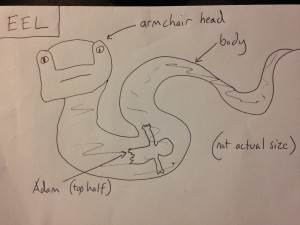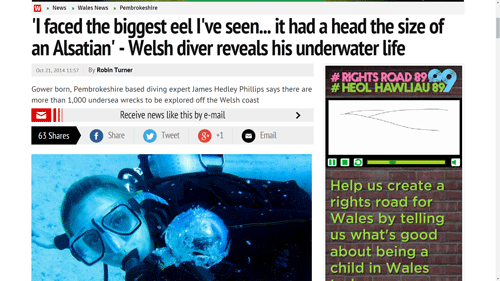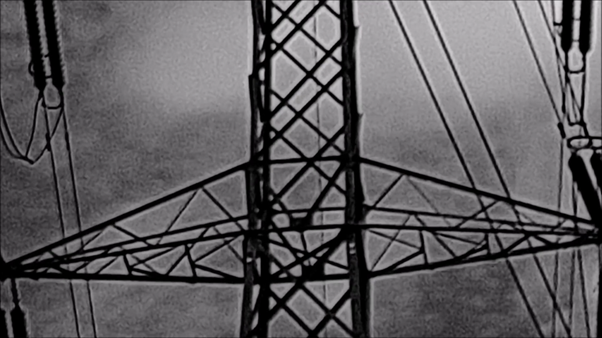WORDS: Gareth E. Rees
In the waters of Dover harbour, there was an eel with a head the size of an armchair.
That was the rumour I heard anyway, aged 15 or thereabouts. Back in the late ’80s.
On Wednesday afternoon I’d go to the beach with the school canoe club and drag an unwieldy kayak across the pebbles, while distant hovercraft rasped towards France. The oily water was so cold we had to wear wetsuits.
Deep below us, the eel would slither along the seabed, feeding on small fish, discarded tyres, and scraps chucked from the sides of ferries.

I can’t remember who told me about the eel. Nobody I’ve spoken to since has any recollection of this rumour. Of course, I never saw it, not in the flesh, but I imagined that it not only had a head the size of an armchair but also the shape of an armchair.
You can get hammerhead sharks, so why not armchair-headed eels?
The eyes of the eel were on situated on the two armrests. Its mouth was like a seat cushion flapping up and down, except with teeth. Its body extended almost half the length of the harbour, but it stayed coiled up most of the time to keep warm.
I knew it couldn’t possibly be an eel. They spend most of their time in freshwater, only taking to the ocean on their quest to the Sargasso Sea. It could have been any number of elongated beasts, however – such as the giant and rarely-spotted oarfish (cf: the top picture on this post). But an eel was what it most certainly probably looked like.
More or less.
In 1907, Charles Dawson, archaeologist and discoverer of the first Iguanadon fossils, spotted a sea serpent in the English Channel from the deck of the steamer SS Manche. He wrote: “I could see no detail except for the long black arched line, dripping into the water at either end.”
Sounds like an eel to me.
Of course, Dawson was later accused of being behind the Piltdown Man fraud, in which he buried an orang-utan’s jawbone near a human skull and called it the Missing Link – fooling the scientific community for 40 years. But this is not to say he wasn’t telling the truth about the serpent.
And before you scoff at this whole idea, look at this illuminating article I found in Wales Online on October 14th 2014.
A large Alsation? That’s getting uncomfortably close to armchair size, in my estimation. At the very least, a Chaise Longue.
Whatever the size and shape of the head, for a hormonal teen such as myself, the eel represented what lay beneath the known. It was a gatekeeper to the afterlife.
The eel strikes
When I was 16, the very few friends I had were drinking in the Castle pub with other people who weren’t my friends but whom I wanted to impress. Over the summer holiday they had all grown bristly square jaws, probably all sharing some growth drug I had not been told about, the bastards. So I had been kicked out of the pub for looking too young, as usual.
This was a regular Saturday night humiliation for me, but this time it stung especially hard. So I walked to the water’s edge and looked at the bright lights of the ships moving to and fro on the horizon. I decided I might commit suicide by walking into the water with pebbles in my pocket. If drowning didn’t kill me, the eel would.
I stood there for quite a while, imagining everybody’s shock and grief, getting quite aroused by the idea of the eel as an agent of my tragic legacy. Then I turned and walked back up the shingle, thinking maybe someone who was tall enough might buy me a can from the offie.
Not very long after that, we were doing canoe club again. Adam – one of those popular big-jawed schoolmates who always got into pubs – paddled far out into the middle of the harbour. Showing off, as usual. After an insolent wave, he did an Eskimo roll, toppling sideways into the water, until all you could see was the yellow underside of his kayak bobbing in the waves.
When he flipped up again, there was only a torso stump sat in the kayak. The top half of his body had been bitten clean off. A long artery waggled from his severed midriff, jetting blood into the air for a good few seconds, before it emptied out and flopped into his exposed internal organs.
I don’t remember what happened after that. Helicopters and people in those plastic contamination suits, most likely.
But anyway, it was a great day.
Gareth E. Rees is author of Marshland: Dreams & Nightmares on the Edge of London. His work appears in Mount London: Ascents In the Vertical City, Acquired for Development By: A Hackney Anthology, and the album A Dream Life of Hackney Marshes.











Was this the inspiration for the scene in Nil by Mouth where Mark is talking about someone he met in prison – “This geezer had the biggest head you’ve ever seen. It was like an armchair”?
That’s weird, perhaps the armchair is a commonly used representation of head-shape and I unwittingly tapped into the meme when I was a kid.